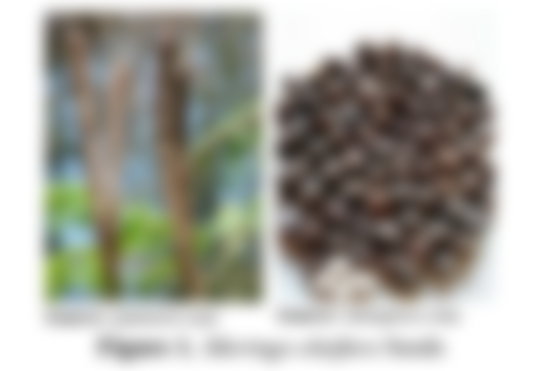Moringa oleifera is a genus of 14 species of flowering plant in the family Moringaceae. It is also called “nebeday” or the tree that never dies. Moringa oleifera is a multipurpose and fast-growing tree. It tolerates a wide range of soils and rainfall conditions. It easily reaches three meters in height, just ten months after planting. It is now extensively cultivated and has become naturalized in many locations in the tropics (James, 1983). Moringa is one of the most useful trees in the world, with a huge amount of benefits. It is used as a micronutrient to treat many diseases. Every part of Moringa oleifera is used in a variety of traditional medicines.
Characteristics of Moringa oleifera Seed

Moringa oleifera seeds shown in Figure 1 consist of a brownish semi-permeable seed hull with a round shape. The hull consists of three white wings at 120-degree intervals, running from top to bottom. About 15,000 and 25,000 seeds/year can be produced by each tree. The average weight/seed is 0.3 g and the kernel to hull ratio is 75: 25 (Makkar and Becker, 1997).
Moringa oleifera seed just like other parts of the tree is found to be medicinal with numerous uses. Mature pods of the tree are edible and they form a part of the traditional diets in many countries and subtropics of the world (Anhwanye et al., 2004). The leaves and seeds of Moringa oleifera are good source of protein, vitamin A, B, C and minerals such as calcium and iron (Dahot, 1988). Moringa oleifera seed is among the most useful, nutritious botanical product with high economic values. It is also recognized as medicinal and herbal remedies; and have been used in industrial and agricultural field because the presence of some chemicals it contains as tabulated in Table 1. Seeds are edible in fresh, dried or with the seed pods. The seeds medicinal properties are well documented and supported by the experience of the traditional Ayurvedic practioners (Amagloh and Benang, 2009). The seeds extract is natural coagulant, mostly used at household for water purification in some villages in Africa such as Sudan. This overcome up to 95 % of water turbidity problem, although it often depends on the initial turbidity level (Katayon et al., 2006). As reported by Hegazy et al., 2011; the seeds show similar effect as alum and less effective in low turbidity water. The seeds contain proteins which are essential in antioxidant properties and water purification. It possesses the capability to remediate water pollution and numerous arrays of illnesses (Amagloh and Benang, 2009). The National Charity for Organic Growing reported that Moringa oleifera seeds are proficient medical treatment to rheumatism, sexually transmitted diseases, urinary infections, epilepsy and gout (Amagloh and Benang, 2009; Sengupta et al., 2012).

Moringa oleifera seed can be processed into powdered state which can be traditionally used as coagulating agent in water purification (Folkard et al., 2002, Anwar et al., 2007). Moringa oleifera seed also contains a significant amount of oil which is commonly known as Ben oil or Behen oil. This was erroneously reported to be resistant to rancidity and used extensively in the effleurage process (Nolabigengeser and Narasaih, 1998).
The characteristics of M. oleifera seed oil can be highly desirable especially with the current trend of replacing polyunsaturated vegetable oils with those containing high amounts of monounsaturated acids (Corbett, 2003). In recent times, increased attention has been focused on the utilization of under-exploited locally available agricultural products and by-products for food/ fibre processing in developing countries. Due to the facts that M. oleifera is harvested and collected manually by handpicking, there are always unwanted materials in all the harvested seeds which necessitates the need for the cleaning of the seeds. For further processing of the harvested seeds, there is a need for the determination of engineering properties, such as physical, chemical and oil properties among others. The knowledge of these properties is highly relevant to agricultural engineers due to the increasing economic importance of food materials, together with the complexity of modern technology for their production, handling, storage, processing, preservation, value addition and utilization (Adebayo and Nwankwo, 2013).
A rational approach to the design of agricultural machinery, equipment, and facilities involve the knowledge of the properties of the agricultural product concerned. The need for comprehensive information on its properties is of importance, as these properties influence the design and evaluation of the processing/ handling of the product. Considering this, the knowledge of the engineering properties of agricultural seed materials are important in designing the equipment for harvest, transport, storage, processing, cleaning, hulling and milling (Niveditha et al., 2013)
Uses of Moringa oleifera Seed
Culinary Uses. The immature seed pods of the Moringa tree, popularly known as drumsticks in India, are used in various dishes. The seeds can be extracted and eaten as "peas" (boiled or fried) when still green. The dry seeds are apparently not used for human consumption, perhaps because the bitter coating becomes hardened (Moringa Products, n.d.).
Cold pressed Moringa oil extracted from Moringa seed has traditionally been used for cooking and in other food preparations. The bright yellow oil with a pleasant taste has been compared in quality with olive oil both having large amounts of oleic acid, however the Moringa oil does not lose its nutritional value when exposed to high heats, like olive oil does, because of its exceptional oxidative stability (Moringa Products, n.d.).
Moreover, Moringa oil is a great alternative in recipes that needs a nutty flavor. It is also a healthy choice to put in stir fry dishes and marinades. It can also be used as dressing for salads and vegetables (Moringa Products, n.d.).
Besides the high content of oleic acid, Moringa oil is rich in vitamins A and C and unsaturated fatty acids. Small amounts of Moringa oil added to the diet of young children can provide them with a more varied and nutritious diet (Moringa Products, n.d.).
Medical Uses. The properties of the oil possess a variety of health benefits such as improving cardiac and circulatory function, cholesterol lowering, having antioxidant, anti-inflammatory, anti-tumor, anti-epileptic, antipyretic, anti-ulcer, antispasmodic, anti-diabetic, antibacterial and antifungal activities, and diuretic properties. These properties are indicated in the study of Herbanext Laboratories Inc. at Negros Occidental. With the assistance of the Department of Science and Technology, Herbanext Laboratories Inc. processes raw materials, extracts oil through different types of extraction, researches for pharmaceutical work, chemistry and microbiology work (Retrieved from: https://www.herbanext.com/laboratory-services).
Uses in Cosmetics. Moringa oil is considered as one of the greatest cosmetics oils ever discovered since it degrades the free radicals in the skin and slowing the aging process down. This is because of its properties such as antioxidants, anti-aging, emollient which has skin moisturizing properties, and exfoliate which removes dead skin cells. The oil is used in the production of soaps, shampoos, body washes, and make-ups.
The Japan-Philippines Malunggay Eco Farm Inc. located at Laguna extracts and sells moringa seed oil. The company indicated that their product is directly applied to skin which balances and nourishes all skin types. A popular cosmetic brand in America, Kjaer Weis owned by Kirsten Kjaer Weis includes this oil in the formula of Kjaer Weis’s body oil which supports elevated microcirculation and improve the appearance of skin’s tone and texture (Retrieved from: https://www.google.com/amp/s/www.allure.com/story/what-is-moringa-oil-skin-care-ingredient/amp). A traditional Chinese medicine practitioner and acupuncturist Annee de Mamiel, founder and formulator of British skin-care brand de Mamiel, also uses moringa oil in the line’s Restorative Cleansing Balm to soothe inflammation and balance acneic skin because of its antibacterial properties.
References
Adesina, B. S., Asiru, W., Omotade, S., & Samuel, D. (2013). Some Physical Properties of Moringa oleifera Seeds. Retrieved September 16, 2020, from Research Paper: https://www.ijser.org/researchpaper/Some-Physical-Properties-of-Moringa-oleifera-Seeds.pdf
Fakayode, O. A., & Ajav, E. A. (2013). PHYSICAL PROPERTIES OF MORINGA (Moringa oleifera) SEEDS IN RELATION TO AN OIL EXPELLER DESIGN. Retrieved September 8, 2020, from https://www.ajol.info/index.php/agrosh/article/view/93735#:~:text=The%20average%20surface%20area%20was,of%20repose%20was%2021.44o.
Global Moringa Meet 2019 demonstrates advancements in production application of moringa. (2019). Retrieved September 17, 2020, from https://www.eco-business.com/press-releases/global-moringa-meet-2019-demonstrates-advancements-in-production-application-of-moringa/
Malunggay (Moringa) Oil Specification. (2012). Retrieved September 18, 2020, from Philippine National Standard (PNS/BAFPS 110:2012): http://bafs.da.gov.ph/2017-10-12-00-46-55/standard-formulation/philippine-national-standards?download=128:pns-bafs-110-malunggay-moringa-oil-specification&start=120
Moringa Products. (n.d.). Retrieved from weebly: https://moringaproducts.weebly.com/blog/moringa-culinary-uses
Munirat, A. I., Mohammed , S. J., Ademola , M. H., & Parveen, J. (2016). Moringa Oleifera Seed Extract: A Review on Its Environmental Applications. Retrieved September 17, 2020, from https://www.ripublication.com/ijaes16/ijaesv11n6_12.pdf

